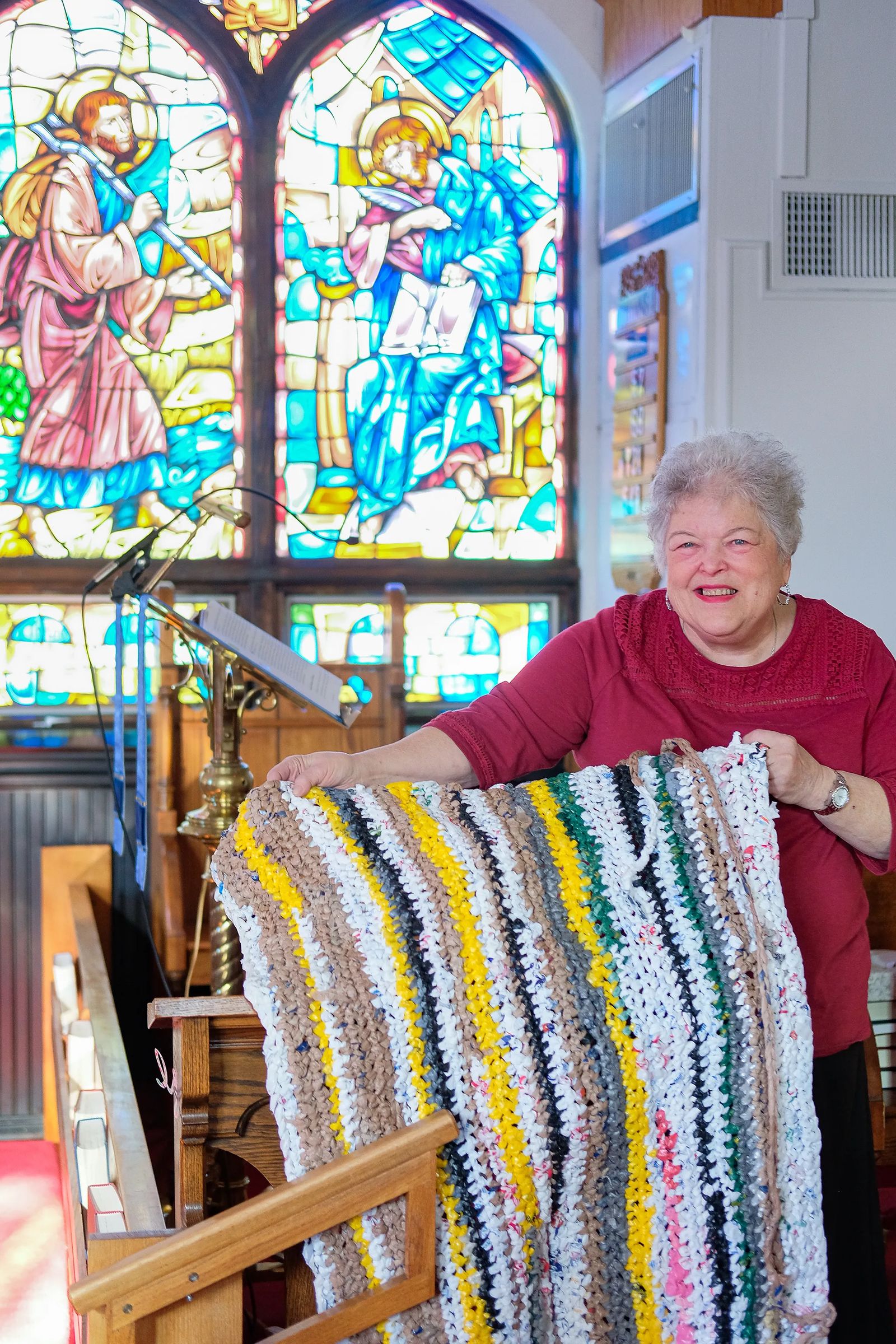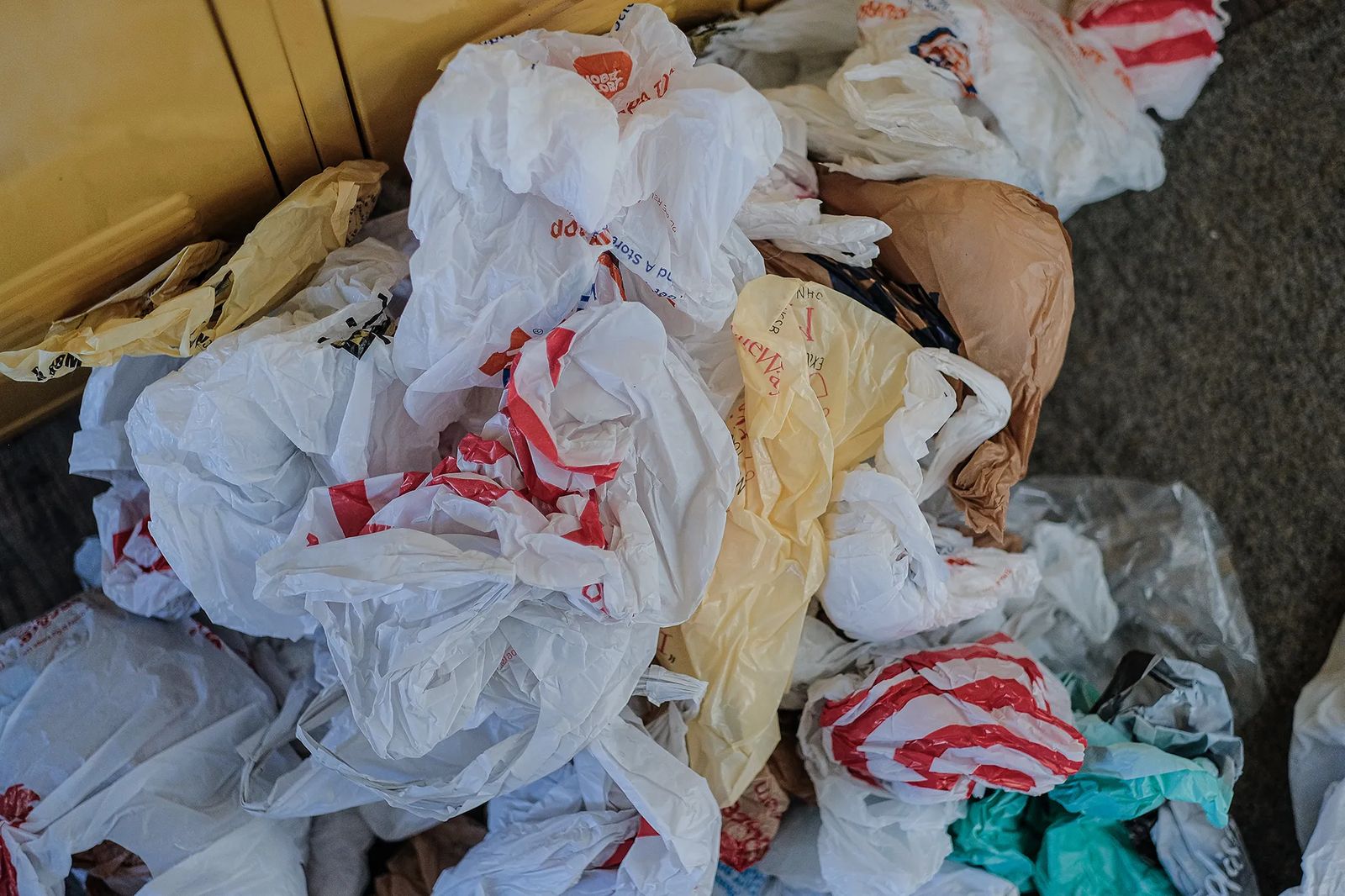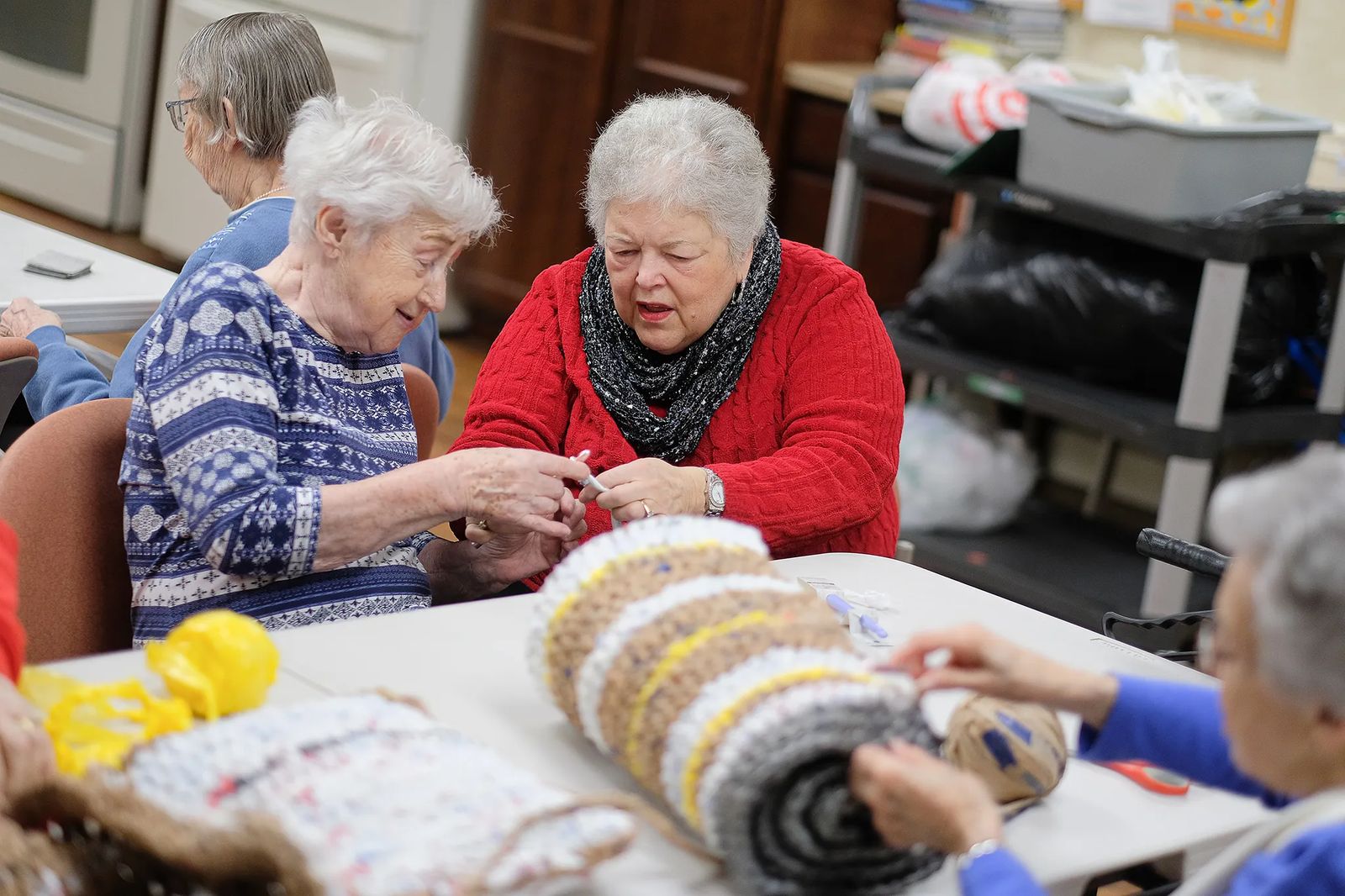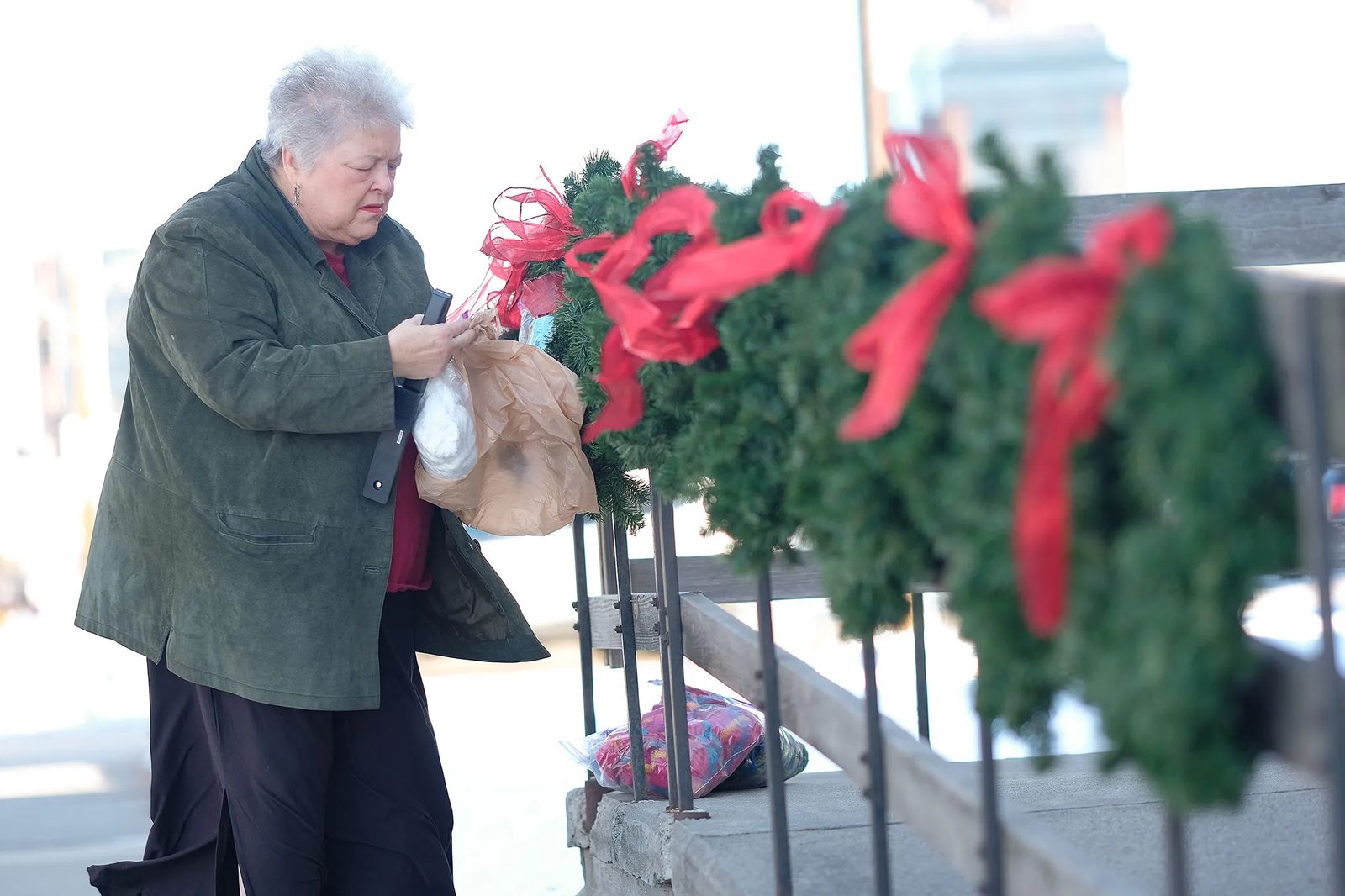
Paying it Forward
Billings woman turns trash into treasure for the homeless
Libby Laird sits with a crochet needle the size of a pencil in one hand, weaving together a variegated mat with colors ranging from bright yellow to white, brown and black.
The rug isn’t one that will decorate her Billings home. Made completely of plastic bags, this project will become a sleeping mat, one of many that will provide a layer of protection to the area’s homeless people who sleep outside.
It takes 500 to 700 bags to make one mat, Laird says, her hands deftly weaving another strip of plastic into the mat. In addition to helping the homeless, crocheting the plastic rugs helps the environment.

“You see so many bags blowing around, hanging off trees, in the garbage dump and it’s just such a problem,” Laird, 73, says. “I thought we could kill two birds with one stone.”
She is quick to say the idea wasn’t hers to begin with. Laird first heard about it four years ago when she visited her sister, Anne Ramsey, in Everett, Washington. A Bible study group led by Ramsey’s friend, Sondra Hirsh, was concerned about the homeless population in their city.
“Particularly because there were so few beds in Everett,” Laird says. “There was a population of 250 homeless and only 50 beds at a mission.”
At first, they tried knitting the mats, “but they weren’t a real success,” she says. So they tried crocheting them, which worked, and the word spread far and wide by word-of-mouth, the media and YouTube videos.
“I was fascinated by it and I didn’t crochet,” she says. “I figured I could learn.”

Laird brought the idea to the women’s group at St. Luke’s Episcopal Church in downtown Billings, which took an interest in it. She is finishing up her fourth and last year as president of the group.
Then, with help from Karen Lahey of Billings, who Laird says “is good at networking,” more people joined together in a group that meets the third Tuesday of every month at the church. The volunteers enjoy a meal, good conversation, crocheting the sleeping mats or helping cut the plastic bags, which are rolled up and tied together to make plastic yarn, or plarn, for the mats.
Laird is also teaching residents at West Park Village how to make the mats. On her own, at home, she will crochet while she watches TV.
“I usually can get a mat done in two weeks,” she said. “Sometimes if it’s a really busy time of year, it will take me a little longer.”
Laird, who retired about four years ago, started out as a radio newscaster in Minnesota, where she also taught TV production to high school students. Eventually, she worked a decade as a newspaper reporter.
In 1997, Laird moved to Billings where another sister, Barbara Scheppele, lives. Scheppele started her own advertising business and invited Laird to join her in the venture.
Laird, who also had been active in the Episcopal church in Minnesota, joined St. Luke’s. She wasn’t raised in the Episcopal denomination, instead coming to it in her late teens, drawn by its expansive, inclusive philosophy.
Faith, she says, informs her life.
“Faith is like inhaling and exhaling,” Laird says. “It’s part of everything you do.”
In Billings, the amount of outreach the downtown church does is part of what attracted her.

In addition to the women’s group, Laird is a member of the church board. She’s also a licensed lay Eucharistic minister, which allows her to take Communion to people’s homes, and she volunteers at the church one afternoon a week.
It all lines up with Laird’s philosophy of faith, what she calls “talent and treasure.”
“It’s not enough to give money to the church,” she says. “You have to give your abilities and your time.”
The work of the Women of St. Luke doesn’t stop with the sleeping mats. Members buy or knit hats and scarves, tag them with a note from St. Luke’s and store them in small, clear plastic bags at the church. When the weather turns cold and snowy, the bags are stapled to the railing outside the church for anyone who needs warm clothing.
The women are filling 25 shoeboxes with hats, mittens, granola bars and hygiene products for clients of Tumbleweed, a Billings nonprofit that works with homeless teens. The group has also put together 140 blessing bags this year filled with hygiene products and socks for clients of the Hub, a drop-in center for those dealing with homelessness.
Every other week, they make sandwiches for the Montana Rescue Mission. And they deliver the sleeping mats to organizations that work with the homeless.
“It’s our way of trying to be good citizens in the community,” Laird says.
When it comes to making the mats, Laird and her band of volunteers generally crochet ones that are 3 feet wide by 5½ or 6 feet long. But some are wider.
“We tell people when we give them out, if you’ve got a dog, there’s room for you both,” Laird says.
Since she started making the mats, Laird has completed more than 40 of them. And the effort continues to grow as more people become part of the mat-making effort.
Lahey first learned about the project through a small newspaper article.
The brief said St. Luke’s was looking for volunteers to help cut the plastic bags to make plarn. It was a good fit for Lahey.
“I’ve been a recycler since junior high,” she says. “I wanted to do this for the recycling part of it to keep bags out of the landfill.” Since then, she’s come to appreciate how the work helps the homeless. Lahey, who also ended up joining St. Luke’s, started a Facebook page called “Sleeping Mats with a Purpose.”
“People asked ‘What are you doing’ and ‘Can I help?’” Lahey says. “I had enough requests and we decided to hold a class two years ago.”
And that turned into the group that continues to meet monthly. In addition to the mats, the volunteers have also started crocheting pillows out of the plarn.
“We stuff them with handles and cutoffs from the bag, so there’s nothing going to the landfill,” she says.
Some mats weigh more than others, depending on the thickness of the bags. The smaller yellow newspaper wraps create smaller loops but weigh more than the white dollar store bags.
Laird laughs as she relates a story about a woman who came to her house as a volunteer helping with yard work. She stepped inside for a moment and expressed concern when she saw bags full of plastic bags in Laird’s house and bits and pieces of plastic in her living room.
The woman asked Laird if she was a hoarder.
“I said ‘Of bags, yes,’” Laird says. “The bags have a lot of static electricity and when you’re cutting and trimming, little pieces float around and stick to the cat, they stick to your shoe, your pant leg. At any given time, there’s plastic floating around everywhere.”
Then Laird grows serious, talking about the people who, thanks to the efforts of the volunteers, sleep a little more comfortably at night. Asked why she does it, Laird says she doesn’t have a lot of money but she has a lot of blessings, including a warm house and enough to eat.
The mats are one way to pass on those blessings.
“It’s me being the hands and feet of Christ in the world,” Laird says. “You do what you can to help others.”
Editor’s Note: Our Paying it Forward feature is a part of Yellowstone Valley Woman’s year-long effort to draw attention to those women who are quietly serving to make our community a better place.












